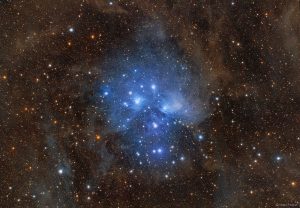
Ripples on Mars, rings around Quaoar and a vortex circling the Sun: it’s time for another roundup of news from around the Solar System!
On February 2, NASA’s Solar Dynamics Observatory recorded a large solar prominence erupting in Sun’s far north, but instead of simply arcing back to the surface the massive filament of plasma broke off and formed a vortex around the Sun’s north pole.
The event was announced in a tweet posted by space weather physicist Dr. Tamitha Skov. “Talk about Polar Vortex!” Skov remarked in the post. “Material from a northern prominence just broke away from the main filament & is now circulating in a massive polar vortex around the north pole of our Star.”
Solar researchers are unsure of what the significance of this breakaway event is, as it is the first time such a phenomenon has been observed, although a solar prominence appears along the same latitude—55 degrees—during each solar cycle. The mechanism behind this is not well understood, although the prevailing theory is that it is a reaction to the sudden reversal of the Sun’s magnetic field roughly every eleven years.
“It’s the first time I have seen something like it,” remarked solar physicist and deputy director of the National Center for Atmospheric Research Scott McIntosh. McIntosh added that just because we haven’t see this happen before doesn’t mean that such an occurrence hasn’t happened in the past.
“Its appearance is more cool than baffling,” McIntosh added. “Our initial observation was more of a gee whizz kind of thing.”
Much, much further out from the Sun, astronomers have discovered that the distant trans-Neptunian dwarf planet Quaoar has a ring system, one that has sent astrophysicists back to the drawing board in regards to how rings form around planetary bodies.
The faint ring was discovered as it occulted the light of a background star while being observed by the Gran Telescopio Canarias (GTC) on La Palma. The fact that a celestial object less than one-quarter the size of Pluto would have a ring system isn’t what’s giving researchers pause—the James Webb Space Telescope found a similar ring around the even-smaller asteroid Chariklo in October 2022—but rather it’s the ring’s distance from Quaoar that is causing the stir.
Ring systems around planets, such as the extensive one circling Saturn, are formed by material that is unable to clump together to form a cohesive satellite due to being too close to the planet. Inside what is known as the Roche limit, tidal forces from the parent body prevent the material from coalescing, forces that can also pull apart a satellite that is unfortunate enough to wander into this moon-munching region.
Depending on the density of the planetary bodies in question, the Roche limit is typically only around two planetary radii from the planet’s surface, but at 4,100 kilometers, Quaoar’s ring is nearly double (2.3 times) the distance out from its Roche limit of 1,780 kilometers.
“It was unexpected to discover this new ring system in our solar system, and it was doubly unexpected to find the rings so far out from Quaoar, challenging our previous notions of how such rings form,” according to study co-author Vik Dhillon, a professor at the University of Sheffield’s Department of Physics and Astronomy.
“Everyone learns about Saturn’s magnificent rings when they’re a child, so hopefully this new finding will provide further insight into how they came to be.”
And bringing things much, much closer to home, NASA’s Curiosity Rover has found the unmistakable mark that an ancient body of water has left on the geology of Mars, in the form of ripples fossilized into the surrounding landscape’s rocks—and in an area that wasn’t expected to have hosted such an environment, no less.
The images of the terrain revealed sedimentary rocks with ripples undulating across their surface, formed by waves washing over the shallows of an ancient lake that, over time, hardened into the rocks as seen by the rover today. Although evidence of open water having been present on the surface of Mars has been found in recent years, this discovery may constitute the strongest case for Mars being a watery planet.
“This is the best evidence of water and waves that we’ve seen in the entire mission,” explained Ashwin Vasavada, Curiosity’s project scientist at NASA’s Jet Propulsion Laboratory. “We climbed through thousands of feet of lake deposits and never saw evidence like this – and now we found it in a place we expected to be dry.”
“The wave ripples, debris flows, and rhythmic layers all tell us that the story of wet-to-dry on Mars wasn’t simple,” Vasavada added. “Mars’ ancient climate had a wonderful complexity to it, much like Earth’s.”
Subscribers, to watch the subscriber version of the video, first log in then click on Dreamland Subscriber-Only Video Podcast link.